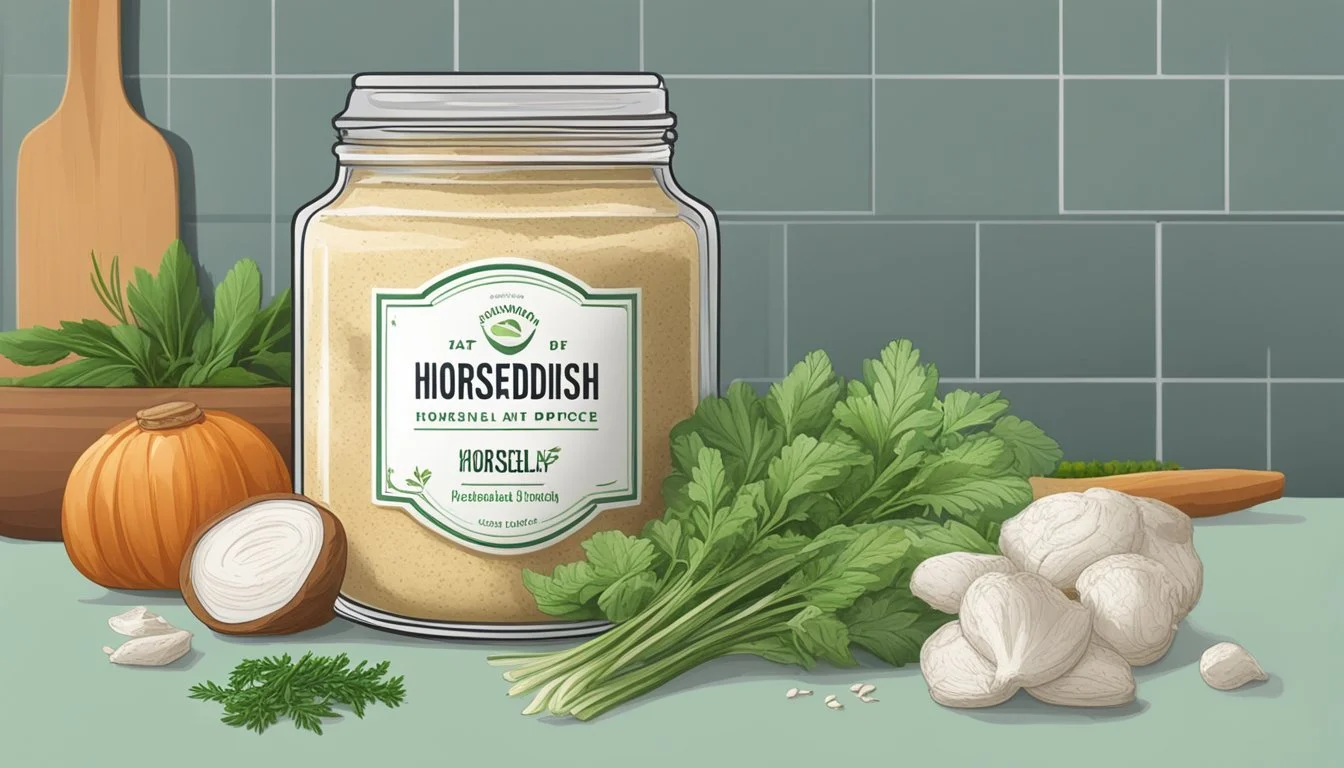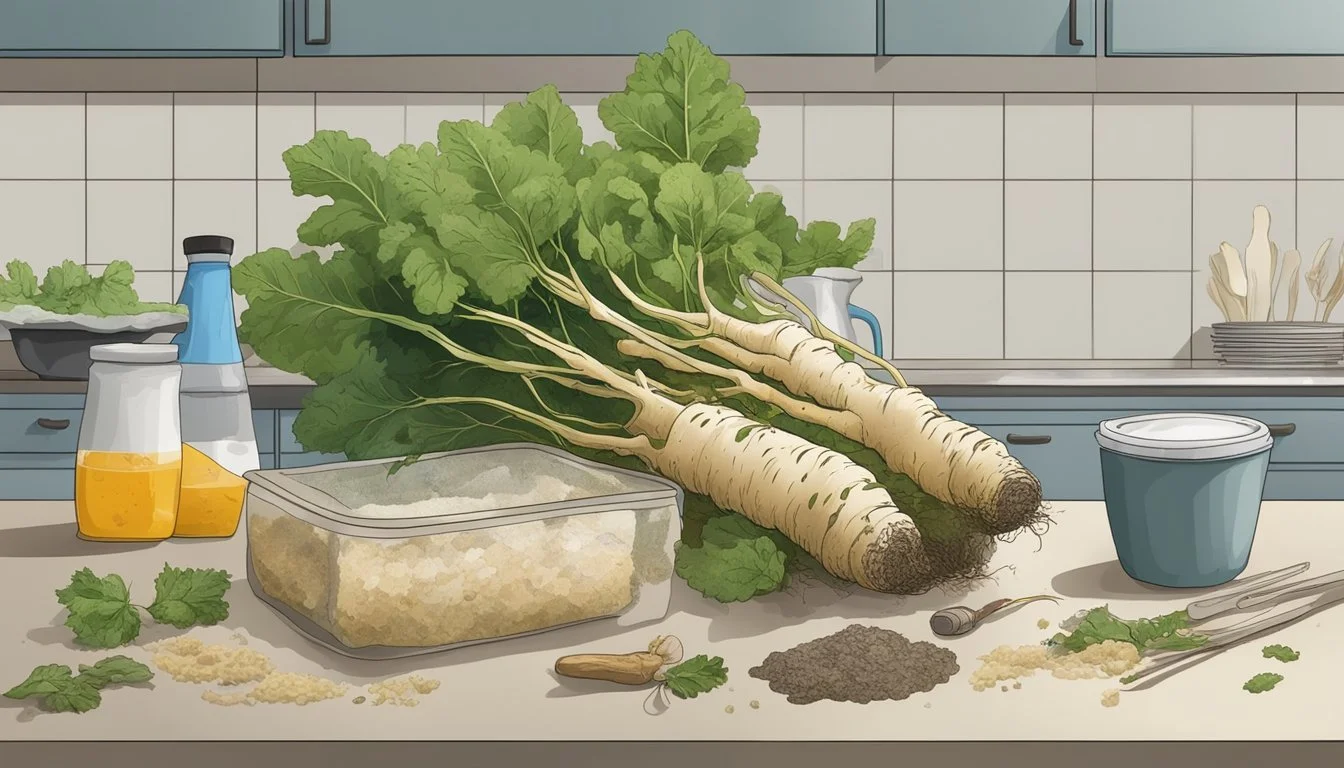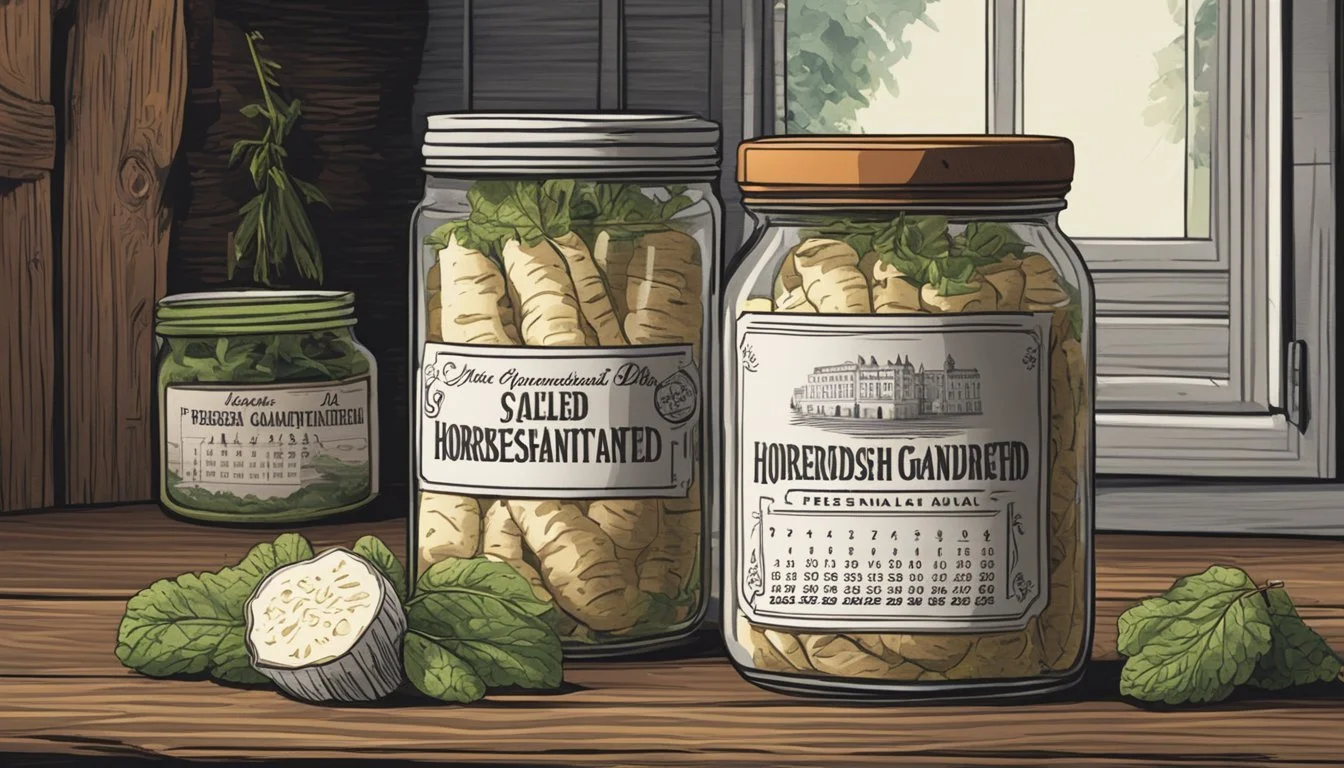Does Horseradish Go Bad?
Shelf Life and Signs of Spoilage
Horseradish, a pungent root often used to add a sharp bite to various dishes, is a staple in many kitchens. However, as with all food items, horseradish can indeed go bad. Fresh horseradish root, grated horseradish, and packaged horseradish sauces all have different shelf lives, and it's crucial to recognize the signs of spoilage to ensure food safety and quality.
Fresh horseradish root can last for a few weeks when stored properly in the refrigerator. Grated horseradish, once opened, typically has a shorter shelf life of about 3-4 months if kept refrigerated. On the other hand, prepared horseradish sauces can vary significantly, with many lasting up to 6-12 months when unopened in the pantry, and about 1-2 months once opened and refrigerated.
Signs of spoilage in horseradish products include mold, discoloration, off smells, and changes in taste. If any of these indicators are present, it's time to dispose of the horseradish to avoid any potential foodborne illnesses. Remember, maintaining proper storage conditions can extend the shelf life of your horseradish.
Understanding Horseradish
Horseradish is a pungent root vegetable that has been used for culinary and medicinal purposes for centuries. It is often used in its root form or as a sauce and offers a unique, spicy flavor.
Different Forms of Horseradish
Horseradish comes in various forms, each suitable for different culinary uses.
Horseradish root is the most basic form and is typically grated or minced before use. It has a strong, fresh, and spicy flavor. Prepared horseradish is usually mixed with vinegar and other ingredients, creating a ready-to-use condiment. This form is easier to store and has a tangy taste.
There are different varieties of horseradish, including common and Bohemian types, each varying slightly in flavor and heat intensity. The method of preparation significantly affects its potency and storage life.
Nutritional Profile
Horseradish is low in calories and fat, making it a healthy addition to many dishes.
A typical serving size of one tablespoon (15 grams) of prepared horseradish contains about 6 calories. It is rich in vitamin C, which supports immune function. Horseradish also has smaller amounts of calcium, potassium, and magnesium.
The root contains compounds like glucosinolates and isothiocyanates, which have antioxidant properties. These compounds may provide potential health benefits, such as reducing inflammation and fighting infections.
Shelf Life and Expiration Date
Horseradish is a potent and flavorful condiment with a varied shelf life that depends on its form and storage conditions. Both unopened and opened horseradish products require attention to expiration dates for optimal usage.
Shelf Life of Different Horseradish Products
The shelf life of horseradish can vary based on preparation and storage. Unopened store-bought horseradish typically lasts 6-12 months in a pantry. Once opened, it should be refrigerated and can last up to 4 months.
Homemade horseradish has a shorter shelf life. It is best consumed within 1-3 months if kept in the refrigerator.
For horseradish sauce, its shelf life varies due to differing ingredients. An unopened jar can last up to a year. Once opened, it should be consumed within 2-4 months if refrigerated.
Reading Expiration Dates
Expiration dates are guidelines for maintaining quality. Best-by dates on unopened jars indicate the period during which the product remains at its peak flavor and potency.
For opened horseradish, it's important to rely on storage practices as much as the dates. Always check for signs of spoilage such as color change, off smell, or mold.
If properly stored, horseradish may still be safe to consume past its expiration date. However, its flavor and potency might diminish over time, impacting the taste of your dishes.
Signs of Horseradish Spoilage
Recognizing when horseradish has gone bad is crucial for maintaining its flavor and avoiding potential health risks. Key indicators of spoilage include visual changes, alterations in odor and flavor, and texture shifts.
Visual Indicators
Visual changes are one of the first signs of spoiled horseradish. Fresh horseradish should be creamy white in color.
Discoloration: If the horseradish turns yellow or brown, it is a sign that it has started to spoil. Additionally, the presence of black spots or any mold growth indicates serious spoilage and contamination.
Mold Growth: Mold can appear as green, white, or black patches. Mold signifies that the horseradish is not safe to eat and should be discarded immediately.
Observing these visual indicators helps in determining the freshness of horseradish and ensures its safety.
Odor and Flavor Changes
The smell and taste of horseradish are strong indicators of its quality. Fresh horseradish has a pungent aroma that is quite sharp and distinct.
Off Smell: If there is an off smell, sourness, or any unusual odor, it suggests that the horseradish has gone bad. This change in smell is a definite sign that it should not be consumed.
Flavor: Taste alteration is another critical signal. Spoiled horseradish might have a milder or slightly rancid taste rather than its usual sharp bite. Any deviation from its typical strong flavor indicates spoilage.
Trusting one's senses for these changes ensures horseradish is still good to use.
Texture Variations
Changes in texture are equally important in identifying horseradish spoilage. Normally, horseradish should have a smooth and consistent texture.
Slimy Texture: If the texture becomes slimy or mushy, it is a clear sign of degradation. Freshly grated horseradish should feel firm and crisp.
Grainy Texture: Another texture warning is when it becomes grainy. This indicates that the horseradish has started breaking down and is no longer in its prime condition.
Ensuring the texture is solid and not showing these signs helps confirm the horseradish is safe to use.
Proper Storage Techniques
Properly storing horseradish ensures it remains fresh and flavorful for as long as possible. Whether unopened, opened, or frozen, maintaining the right conditions is essential.
Storing Unopened Horseradish
Unopened horseradish, whether it’s the root or sauce, should be kept in a cool, dark place to extend its shelf life. For store-bought jars, this usually means the pantry or a cupboard. The ideal storage temperature is around 50°F (10°C).
Fresh, unpeeled horseradish root can be stored in this manner for 3-4 weeks. Keeping the roots in perforated plastic bags can help maintain optimal humidity levels and prevent them from drying out.
For unopened jars of horseradish sauce, check the "best by" date on the label to determine how long it should last. Keeping them stored properly away from heat sources and direct sunlight will maintain quality.
Refrigerating Opened Horseradish
Once opened, horseradish should be refrigerated to maintain its pungency and prevent spoilage. Both fresh roots and horseradish sauces need to be stored in an airtight container to limit exposure to air, which can degrade flavor and texture.
Freshly grated horseradish root can last up to two weeks in the refrigerator. Keeping it in a tightly sealed jar or plastic container within the fridge's crisper drawer helps retain its freshness.
For opened jars of horseradish sauce, ensure the lid is tightly closed after each use. Properly refrigerated, the sauce can last several months past its "best by" date, retaining its strong, sharp flavor.
Freezing Horseradish
Freezing is another effective way to prolong horseradish's shelf life. To freeze fresh horseradish, first peel and grate the root. Pack the grated horseradish into airtight plastic containers or freezer bags, removing as much air as possible.
Label the containers with the date before placing them in the freezer. Properly stored, frozen horseradish can last up to six months. When using frozen horseradish, take out only the amount needed and reseal the container quickly to minimize exposure to air.
For horseradish sauce, freezing is less common as it may alter the texture. However, if opted for, portion the sauce into small containers and ensure they are tightly sealed before freezing to maintain quality.
Effect of Spoilage on Health
Consuming spoiled horseradish can pose various health risks. Proper storage and regular checks can help prevent these risks and ensure food safety.
Risks of Consuming Spoiled Horseradish
Spoiled horseradish can lead to food poisoning due to the growth of harmful bacteria such as Listeria, Salmonella, and E. coli. These pathogens thrive in improperly stored food.
Symptoms of foodborne illness include nausea, vomiting, diarrhea, and abdominal pain. Severe cases may lead to dehydration and hospitalization. The risk is particularly high for individuals with weakened immune systems, the elderly, pregnant women, and young children.
Always check for changes in color, texture, and smell. Spoiled horseradish often has a sour or off-putting odor and may become discolored or mushy.
Preventing Foodborne Illness
To avoid foodborne illness, store horseradish properly. Keep it in an airtight container in the refrigerator to extend its shelf life. Homemade horseradish should be consumed within a few weeks, while commercial products often last longer but still require refrigeration.
Check expiration dates regularly. Discard horseradish past its "use-by" date, especially if signs of spoilage are present. Clean utensils before use to avoid contamination.
Proper hygiene practices, such as washing hands and surfaces before handling food, also play a critical role in preventing spoilage and ensuring food safety.
Maintaining Freshness and Potency
Keeping horseradish fresh and potent involves understanding the importance of proper storage techniques and the role of certain ingredients. Focus on how vinegar and temperature affect the pungent flavor and spiciness of grated horseradish and horseradish sauce.
The Role of Vinegar
Vinegar is fundamental in maintaining the pungency and flavor of horseradish.
When adding vinegar to freshly grated horseradish, it helps to stabilize the enzymes that contribute to its potent kick. This also prevents the root from browning and losing its spiciness.
In horseradish sauce, vinegar acts as a preservative, extending the shelf life significantly. The acid in vinegar slows down microbial growth, ensuring the sauce retains its sharpness for longer. For best results, mix grated horseradish with vinegar immediately after grating to capture the freshest flavors.
Using the right type of vinegar, like white vinegar or apple cider vinegar, can also affect the overall taste profile, making your horseradish more appealing.
Impact of Temperature and Oxygen
Temperature and oxygen levels are crucial in preserving the freshness and potency of horseradish.
Fresh horseradish roots should be stored in a cool, dark place, ideally in a perforated plastic bag in the vegetable crisper of a refrigerator. This method helps keep the roots fresh for 3 to 4 weeks by maintaining a low temperature and reducing oxygen exposure.
Refrigeration is key for both fresh and grated horseradish. Peeled and cut roots should be stored in airtight containers to limit oxygen exposure, which can degrade their pungency and flavor within two weeks.
For horseradish sauce, keeping it refrigerated after opening ensures it maintains its sharpness and spiciness. Unopened jars can be stored in the pantry, but once opened, they must be refrigerated to maintain quality for up to 4 months.
Storing your horseradish correctly preserves its unique qualities, ensuring every use is as flavorful as the first.
Utilization and Handling
Ensuring proper use and hygiene with horseradish can enhance its flavor and prolong its shelf life. Attention to correct incorporation in recipes and clean handling will maintain its quality.
Incorporating Horseradish in Recipes
Horseradish is a versatile condiment that can add a tangy kick to various dishes. Freshly grated horseradish is often used in sauces such as cocktail sauce or as a spice in Bloody Marys.
To maximize its pungency, grate it just before use. Horseradish sauce, a mix of grated horseradish and vinegar, pairs well with roast beef and other meats. Adding it to mashed potatoes or salad dressings can give these dishes an extra zest.
For soups and stews, a small amount can enhance the taste without overwhelming other flavors. Combining horseradish with sour cream or mayonnaise creates a creamy condiment that balances its sharpness.
Hygiene and Clean Cutlery
Maintaining hygiene when handling horseradish is paramount. Always use clean spoons and knives to prevent contamination. Never use the same utensil for scooping out horseradish and other ingredients unless thoroughly washed.
Store horseradish in an airtight container in the refrigerator to keep it fresh longer. Washing hands before and after handling is crucial, as its strong flavor can linger on surfaces and can irritate eyes if touched.
Using dry and sterilized utensils minimizes the risk of mold and bacteria formation, ensuring the horseradish remains safe and flavorful.
Tips for Buying and Preparing Horseradish
Selecting the right horseradish root and knowing how to prepare it properly are key to ensuring its quality and longevity. Follow these guidelines to make the most out of your horseradish, whether you're buying it fresh or preparing it at home.
Selecting the Best Fresh Root
When choosing fresh horseradish root, look for roots that are firm and unblemished. The texture should be smooth without any signs of softness or discoloration. Freshness ensures maximum potency and flavor for your dishes.
Characteristics to check:
Firmness: Avoid roots that feel soft or limp.
Color: Choose roots free from dark spots or mold.
Size: Larger roots are easier to handle and grate.
It's also helpful to give the root a sniff. A fresh horseradish root has a pungent and sharp smell. This indicates that it's still potent and will provide the spice you need.
Preparation and Packaging
Once you've selected your root, you need to handle it properly to maintain its flavor and longevity. Start by washing and peeling the root. Grate it finely and mix it with vinegar and salt to preserve its intensity.
For homemade horseradish, store it in airtight containers in the refrigerator. This helps keep it fresh for several weeks. Label the container with the preparation date to track its freshness easily.
Store-Bought Sauce: If opting for commercially prepared horseradish, check the expiration date and store it properly. Unopened jars can be kept in the pantry, while opened jars should be refrigerated.
Use airtight packaging to prevent moisture and contaminants from diminishing its quality. Proper preparation and storage not only preserve the spice but also ensure that your horseradish remains a flavorful addition to your meals.
Common Misconceptions
When it comes to horseradish, several misconceptions can lead to improper storage and unnecessary disposal. It's crucial to understand the facts around horseradish shelf life and storage to maximize its use.
Myth versus Reality
Many believe horseradish becomes unsafe immediately after its expiration date. In reality, horseradish is often safe months after its "best by" date. Proper storage, such as refrigerating fresh horseradish, is essential in maintaining its quality and extending its shelf life. Another common myth is that horseradish with a milder taste has gone bad. While its potency may decrease over time, a milder taste indicates aging rather than spoilage. Odors are a more reliable indicator: a sour or off smell can signify it’s time to toss it.
Misunderstood Storage Myths
People often think horseradish should be frozen to extend its life. Freezing and then thawing horseradish can compromise its texture and potency. Instead, refrigerating fresh horseradish is more effective. Some also mistakenly believe that once refrigerated, horseradish can be stored indefinitely. Fresh horseradish generally lasts 1-3 months in the fridge and horseradish sauce about six months. Once signs of spoilage, such as unusual textures or odors, are detected, it should be discarded. Properly sealing and storing horseradish away from direct light and heat further prolongs its usability.









